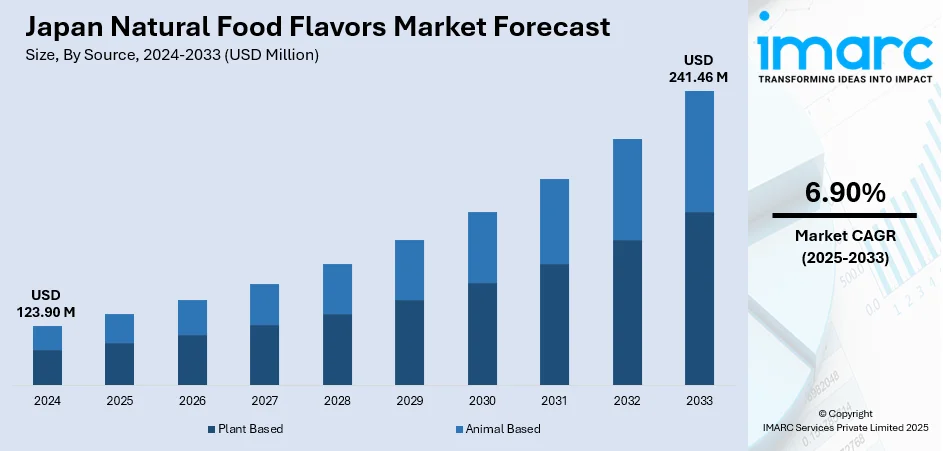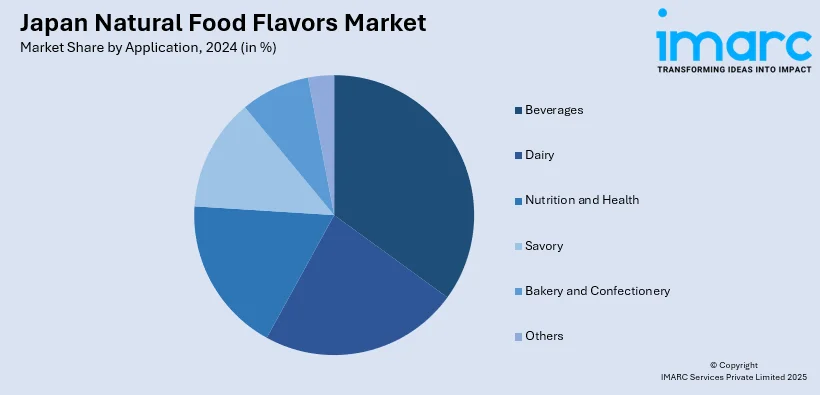
Japan Natural Food Flavors Market Size, Share, Trends and Forecast by Source, Flavor Type, Application, and Region, 2025-2033
Japan Natural Food Flavors Market Overview:
The Japan natural food flavors market size reached USD 123.90 Million in 2024. Looking forward, IMARC Group expects the market to reach USD 241.46 Million by 2033, exhibiting a growth rate (CAGR) of 6.90% during 2025-2033. Increasing consumer demand for healthier, clean-label products, growing awareness of natural ingredients, a shift toward organic and plant-based foods, and rising preferences for sustainable, eco-friendly sourcing and production methods in the food and beverage sectors are some of the factors contributing to Japan natural food flavors market share.
|
Report Attribute
|
Key Statistics
|
|---|---|
|
Base Year
|
2024 |
|
Forecast Years
|
2025-2033
|
|
Historical Years
|
2019-2024
|
| Market Size in 2024 | USD 123.90 Million |
| Market Forecast in 2033 | USD 241.46 Million |
| Market Growth Rate 2025-2033 | 6.90% |
Japan Natural Food Flavors Market Trends:
Growing Green Tea's Role in Natural Food Flavors
Japanese green tea is gaining popularity as a natural food flavor, being creatively incorporated into a variety of international dishes. Restaurants and dessert shops are experimenting with green tea's unique taste, pairing it with flavors from French, Italian, and other global cuisines. This expansion into savory dishes and sweets underscores the growing demand for natural, health-conscious ingredients. Green tea’s rich, earthy notes provide an innovative and versatile flavor profile that enhances both non-alcoholic beverages and desserts. Its rising use reflects a broader shift toward natural food flavors, offering consumers healthier, flavorful options that combine tradition with modern culinary trends. These factors are intensifying the Japan natural food flavors market growth. For example, in November 2024, the Japan Food Product Overseas Promotion Center (JFOODO) partnered with top restaurants and sweets shops in New York and Los Angeles to create special menus featuring premium Japanese green teas. These collaborations introduce innovative flavor pairings with French, Italian, and other cuisines, along with desserts using Japanese green teas. The initiative aims to showcase green tea's rich taste, health benefits, and versatility, offering unique non-alcoholic drinks and sweets to a global audience.

To get more information on this market, Request Sample
Rise of Plant-Based Ingredients
There’s an increasing shift toward plant-based ingredients in the natural food flavors market, driven by growing consumer interest in sustainability and health-conscious eating. As more people embrace plant-based diets, food manufacturers are turning to plant-derived extracts and flavors to create innovative, guilt-free products. Ingredients like pea protein, coconut, and mushrooms are being used to mimic traditional animal-based flavors, offering rich, savory notes while maintaining a natural profile. These plant-based alternatives are not only healthier but also cater to a broader range of dietary preferences, from vegans to those with food sensitivities. The demand for clean-label products that are free from artificial additives is pushing companies to explore nature’s offerings, tapping into fruits, herbs, and spices to develop rich, authentic flavors. With rising awareness of the environmental impact of animal farming, consumers are increasingly seeking plant-based options that are both delicious and sustainable. This movement toward plant-powered ingredients is reshaping the food industry, encouraging innovation and expanding choices for eco-conscious consumers.
Japan Natural Food Flavors Market Segmentation:
IMARC Group provides an analysis of the key trends in each segment of the market, along with forecasts at the regional level for 2025-2033. Our report has categorized the market based on source, flavor type, and application.
Source Insights:
- Plant Based
- Animal Based
The report has provided a detailed breakup and analysis of the market based on the source. This includes plant based and animal based.
Flavor Type Insights:
- Fruit and Flavor
- Vegetable Flavor
- Herb and Spice Flavor
- Dairy Flavor
- Others
A detailed breakup and analysis of the market based on the flavor type have also been provided in the report. This includes fruit and flavor, vegetable flavor, herb and spice flavor, dairy flavor, and others.
Application Insights:

- Beverages
- Dairy
- Nutrition and Health
- Savory
- Bakery and Confectionery
- Others
A detailed breakup and analysis of the market based on the application have also been provided in the report. This includes beverages, dairy, nutrition and health, savory, bakery and confectionery, and others.
Regional Insights:
- Kanto Region
- Kansai/Kinki Region
- Central/Chubu Region
- Kyushu-Okinawa Region
- Tohoku Region
- Chugoku Region
- Hokkaido Region
- Shikoku Region
The report has also provided a comprehensive analysis of all the major regional markets, which include Kanto region, Kansai/Kinki Region, Central/Chubu Region, Kyushu-Okinawa Region, Tohoku Region, Chugoku Region, Hokkaido Region, and Shikoku Region.
Competitive Landscape:
The market research report has also provided a comprehensive analysis of the competitive landscape. Competitive analysis such as market structure, key player positioning, top winning strategies, competitive dashboard, and company evaluation quadrant has been covered in the report. Also, detailed profiles of all major companies have been provided.
Japan Natural Food Flavors Market News:
- In March 2025, Otsuka Pharmaceutical launched the "SOYJOY Black Sesame" bar, expanding its SOYJOY brand. Made with black sesame, this low-glycemic, gluten-free nutrition bar combines plant protein from soy and the rich, aromatic flavor of sesame. The product aligns with growing demand for health-conscious, convenient foods, offering a nutritious snack that complements meals and supports a healthy lifestyle. The SOYJOY brand continues to focus on preserving natural flavors while delivering essential nutrients.
Japan Natural Food Flavors Market Report Coverage:
| Report Features | Details |
|---|---|
| Base Year of the Analysis | 2024 |
| Historical Period | 2019-2024 |
| Forecast Period | 2025-2033 |
| Units | Million USD |
| Scope of the Report |
Exploration of Historical Trends and Market Outlook, Industry Catalysts and Challenges, Segment-Wise Historical and Future Market Assessment:
|
| Sources Covered | Plant Based, Animal Based |
| Flavor Types Covered | Fruit and Flavor, Vegetable Flavor, Herb and Spice Flavor, Dairy Flavor, Others |
| Applications Covered | Beverages, Dairy, Nutrition and Health, Savory, Bakery and Confectionery, Others |
| Regions Covered | Kanto Region, Kansai/Kinki Region, Central/Chubu Region, Kyushu-Okinawa Region, Tohoku Region, Chugoku Region, Hokkaido Region, Shikoku Region |
| Customization Scope | 10% Free Customization |
| Post-Sale Analyst Support | 10-12 Weeks |
| Delivery Format | PDF and Excel through Email (We can also provide the editable version of the report in PPT/Word format on special request) |
Key Questions Answered in This Report:
- How has the Japan natural food flavors market performed so far and how will it perform in the coming years?
- What is the breakup of the Japan natural food flavors market on the basis of source?
- What is the breakup of the Japan natural food flavors market on the basis of flavor type?
- What is the breakup of the Japan natural food flavors market on the basis of application?
- What is the breakup of the Japan natural food flavors market on the basis of region?
- What are the various stages in the value chain of the Japan natural food flavors market?
- What are the key driving factors and challenges in the Japan natural food flavors market?
- What is the structure of the Japan natural food flavors market and who are the key players?
- What is the degree of competition in the Japan natural food flavors market?
Key Benefits for Stakeholders:
- IMARC’s industry report offers a comprehensive quantitative analysis of various market segments, historical and current market trends, market forecasts, and dynamics of the Japan natural food flavors market from 2019-2033.
- The research report provides the latest information on the market drivers, challenges, and opportunities in the Japan natural food flavors market.
- Porter's five forces analysis assist stakeholders in assessing the impact of new entrants, competitive rivalry, supplier power, buyer power, and the threat of substitution. It helps stakeholders to analyze the level of competition within the Japan natural food flavors industry and its attractiveness.
- Competitive landscape allows stakeholders to understand their competitive environment and provides an insight into the current positions of key players in the market.
Need more help?
- Speak to our experienced analysts for insights on the current market scenarios.
- Include additional segments and countries to customize the report as per your requirement.
- Gain an unparalleled competitive advantage in your domain by understanding how to utilize the report and positively impacting your operations and revenue.
- For further assistance, please connect with our analysts.
 Request Customization
Request Customization
 Speak to an Analyst
Speak to an Analyst
 Request Brochure
Request Brochure
 Inquire Before Buying
Inquire Before Buying




.webp)




.webp)












